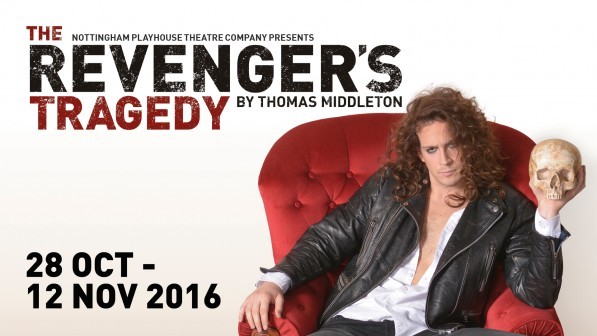
November 2, 2016, by Peter Kirwan
The Revenger’s Tragedy @ Nottingham Playhouse
NB This review is based on a preview performance.
The most striking image of Fiona Buffini’s new production of The Revenger’s Tragedy was that of the opening, with a narrow shaft of light from on high illuminating a skull sat on a chair. Then, to the sound of T-Rex’s ‘Children of the Revolution’, the Duke, Duchess, Lussurioso and Spurio appeared, dressed in a combination of flares, catsuits, big wigs and medallions. The juxtaposition of the skull and glam rock set out the production’s still neatly – an exploration of the dark side of the excessive, hedonistic world of the 1970s, in a backdating of the contemporary ‘Jacobean’ aesthetic set out by Susan Bennett, Pascale Aebischer and others.
The hedonism of the 70s made for some mixed effects. On the one hand, the production suffered from the same issues that dogged previous ‘edgy’ Playhouse productions of not being remotely sexy; the revelation of the Duke in a gimp mask being ridden by the Duchess was one of the most awkward, with neither party looking even remotely invested in the activity. Navinder Bhatti was wooden as Spurio and had no chemistry with Tabitha Wady’s Duchess, making their moments of clawing at each others’ pants excruciating.
But on the other hand, one very specific 1970s allusion resonated – the dressing of the Duke as Gary Glitter, with a predilection for schoolgirls (including the very young Castiza (Isabel Adams). While this led to a somewhat reductive set of relationships among Vindice’s family, it emphasised the perversity of both the Duke and Lussurio’s lust, making their sexual licence perverse rather than merely excessive. Paul Brightwell was disgustingly smug as the Duke, winking at the offences of Lussurioso while beckoning a bevy of young girls into his bed, and the entitlement with which he performed his actions was abhorrent. Adams drew on this further in a well-staged final confrontation between her and her mother (Mary Jo Randle), with Castiza on high platform heels and wearing a tiny skirt, visually stressing the pressure placed on her to sexualise herself beyond her age.
What this all meant was that The Revenger’s Tragedy became a surprisingly straightforward moral crusade, and nowhere was this more apparent than in Vindice (Alexander Campbell) being portrayed as surprisingly strait-laced, especially when compared to his more sophisticated, colourful brother Hippolito (Nathan Clarke). Dressed in plain clothes and checked shirt, Vindice was divorced from the worlds of fashion and fame, living a backwater life and apparently oblivious to the modes of behaviour that characterised the court; far more so than in any other production I’ve seen, it was Hippolito who had to help Vindice disguise himself and instruct him in how to present himself. The shift in dynamic was interesting, though at odds with some of Vindice’s more caustic and self-aware lines; nonetheless, it made for a clear story.
The production seemed unsure of its text, at times. It preserved the incorrect name by which Hippolito is first addressed by his mother, which most productions correct, and Ambitioso was regendered to a sister (Bethan Mary-James), except in Supervacuo’s rhyming couplet where ‘brother’ was preserved to rhyme with ‘another’. The production’s lack of confidence in its own interpretation showed in other ways, most notably during the final masque. While the dancing was excellent (Lussurioso’s Saturday Night Fever impression especially), the production completely copped out of the second tier of deaths, simply showing an odd slo-mo sequence where Spurio, Ambitioso and Supervacuo all stabbed each other for no apparent reason.
Interestingly, though, the production’s most coherent and dominating presence was Declan Perring’s Lussurioso. Played in high camp, he evoked for me Frank ‘N Furter more than anyone else, with his posturing, his sudden explosions of screaming, and his utter fascination with sex. Lussurioso was fey and confident, fawning over ‘Piato’ and Hippolito one moment and then standing up stark naked from a bath the next to bawl at his underlings. Lussurioso was a player but driven by emotional and even irrational reactions that left him vulnerable to the more stolid Duke, the cynical Spurio or the reserved Vindice. As Lussurioso bounced between the different people playing him, however, he also found his own rhythm, and by the masque scene was confidently dominating the stage, even if he was finally grabbed from both sides by the revenging brothers.
Even more of a star was Gloriana, a skull on top of a dressmakers’ dummy who looked splendid in Neil Murray and Mark Jonathan’s design for the murder that served as the climax of Act One. Kept in the shadows and gliding smoothly on wheels, Gloriana was a sinister, haunting presence that looked plausibly human – enough for the Duke to march right up to her and kiss her before realising her true nature. Vindice’s ghoulish dancing with her, followed by taking her head right off in order to show her more clearly to the Duke, showed his own conflicted morality, even if Campbell’s relatively equanimous performance didn’t quite mesh with the extremes of Vindice’s behaviour.
While the production might not have had the energy it hoped, it did enact the role of the revenger in clearing up excess and debauchery. The close was surprisingly moving, as Vindice and Hippolito put their arms around one another and walked off upstage to the strains of the closing piano from ‘Bohemian Rhapsody’, and with only the suited Antonio left, the emptiness left by their absence felt important.
No comments yet, fill out a comment to be the first

Leave a Reply